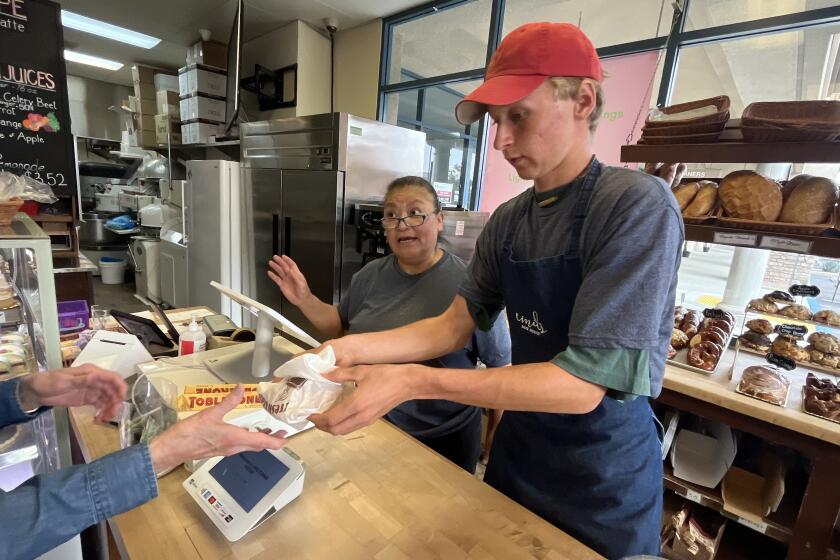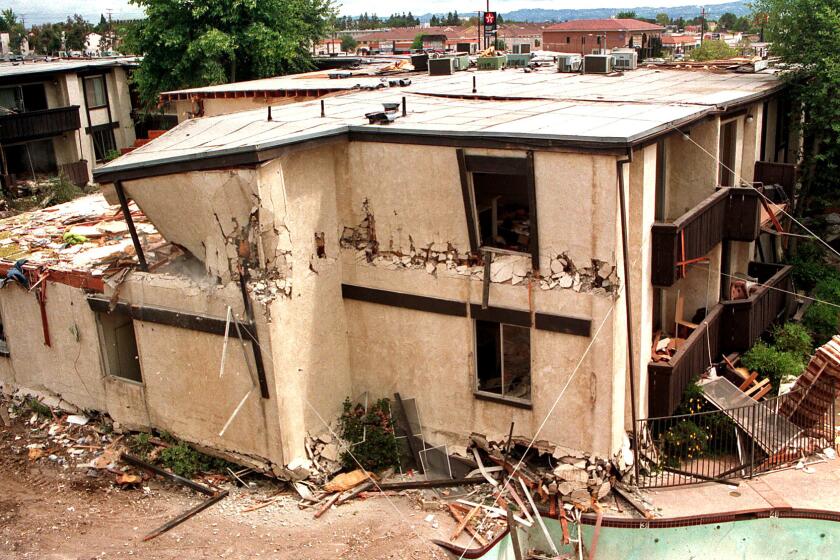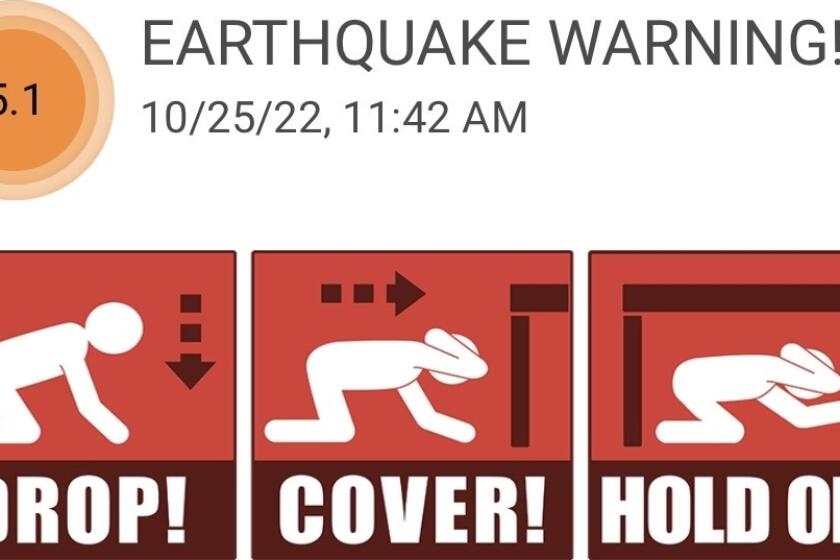
- Share via
- Several suburbs closest to the widely felt earthquakes that struck Los Angeles County this summer and fall have no active plans to require retrofits for seismically flimsy “soft-story” apartment buildings.
- Other cities have been successful in retrofitting such buildings after passing local ordinances requiring that work.
Southern California is seeing its most seismically active year in decades, but some cities near the epicenter of recent temblors have yet to require retrofits of many apartment buildings deemed most at risk of collapse, a Times investigation has found.
Several suburbs closest to the widely felt earthquakes that struck Los Angeles County this summer and fall — including Alhambra, Monterey Park and South Pasadena — have no active plans to require retrofits for seismically flimsy “soft-story” apartment buildings, according to interviews with local officials and a review of existing seismic policies.
In Malibu, which was hit by modest earthquakes in February and September, city officials recently completed an inventory of 37 potential soft-story buildings.
But elected officials there haven’t publicly indicated whether they will mandate that those structures be retrofitted.
It’s been an unusually active year for earthquakes in Los Angeles, as Thursday morning’s magnitude 4.7 Malibu temblor shows.
Soft-story apartments are ubiquitous across California. The term applies to apartment buildings built decades ago where the bottom floor has room for a carport, garage or retail shop. In these buildings, the ground floor can be held up by flimsy, skinny poles that can collapse when shaken side-to-side in an earthquake.
“These are particularly dangerous, hazardous conditions for buildings,” said Garrett Mills, president of the Structural Engineers Assn. of Southern California.
But for residents in soft-story apartment buildings, lines on a municipal map could be all that determines whether their home is seismically strengthened.

There’s a clear pattern of many soft-story apartments being retrofitted after cities pass local ordinances requiring that work. In San Francisco, 94% of 4,941 apartment buildings affected by a soft-story retrofit law passed in 2013 have since been strengthened, said Brian Strong, the city’s chief resilience officer. That law covers wood-frame buildings that are at least three stories and have five or more residential units.
The city of Beverly Hills passed a mandatory retrofit program in 2018. As of June, only 42 out of 229 soft-story buildings — just 18% — had not yet been retrofitted.
Santa Monica passed a new mandatory retrofit law in 2017, following up on an ordinance passed in the late 1990s that hadn’t been enforced. So far, 1,086 of 1,686 soft-story buildings have been retrofitted — a completion rate of 64%.
Los Angeles, too, has made progress on soft-story retrofits since the city passed its law in 2015 — though exactly how much is unclear. In its last update issued in February, Los Angeles officials said more than 9,000 out of a little more than 12,000 soft-story buildings had been retrofitted.
However, that number is no longer seen as reliable after a Times report found errors in the city’s data, and work is underway to ascertain a more accurate figure.
After a Times investigation, Los Angeles building officials commit to hiring an auditor to review building database.
California officials have known for generations about this structural flaw, and the danger it presents. During the predawn magnitude 6.7 Northridge earthquake of 1994, 16 people died when the ground floor of the Northridge Meadows apartment building collapsed, crushing sleeping residents in their beds. In all, the earthquake seriously damaged or destroyed about 200 soft-story buildings across the Los Angeles area.
During the magnitude 6.9 Loma Prieta earthquake of 1989, the ground floors of several apartment buildings in San Francisco’s Marina District crumbled.
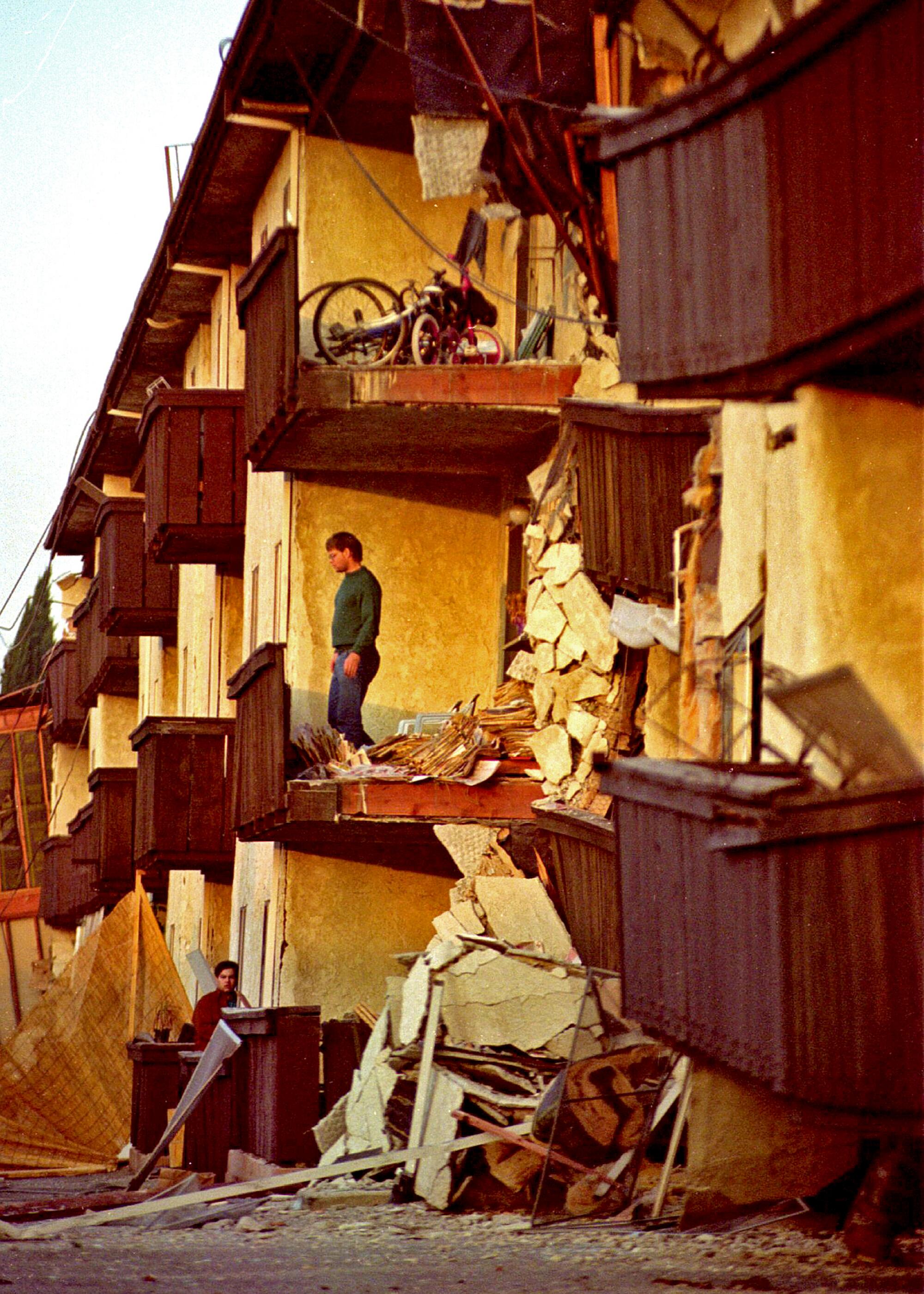
Structural fixes can involve installing steel frames on the ground floor, as well as strengthening existing walls on the flimsy first story.
Some property owners have bristled at the idea of cities mandating retrofit work, however — particularly without additional government funding to help cover the cost. In a recent blog post published when the city of Burbank decided to move forward with such an ordinance, the Apartment Assn. of Greater Los Angeles called mandatory seismic retrofits “brutally expensive” and said they could force mom-and-pop owners to sell their properties.
Officials have estimated that the typical retrofit of a soft-story building in L.A. costs from $80,000 to $160,000, although costs can vary depending on the size of the building.
Others contend that retrofits should be considered a cost of doing business, given how owners are on the hook for things like replacing leaky roofs or upgrading old electrical panels. Many longtime owners have likely gained significant equity in recent decades due to rising property values, and retrofits will also keep rent checks flowing to owners by helping limit damage after an earthquake hits.
Limiting liability is also a concern. Jurors have previously sided with the families of earthquake victims against property owners who were told of the risk by government agencies but didn’t do the retrofit before a damaging earthquake struck.

Why apartments can collapse in an earthquake. Flimsy ground story walls for carports, garages or stores can crumble in an earthquake, and are called “soft-story” buildings, explains U.S. Geological Survey geophysicist Ken Hudnut.
According to a Suffolk University/Los Angeles Times poll conducted in March 2023, Los Angeles residents strongly back the city’s earthquake retrofit law, despite conventional wisdom that it would be politically unpopular because of its cost. More than 8 in 10 L.A. residents supported the retrofit law, that poll found.
“This is something that not only kills people — as we saw in ’94 — but it also leaves people homeless. And we have enough of a homeless problem already,” seismologist Lucy Jones, a Caltech research associate, said at a news conference following an Aug. 12 magnitude 4.4 earthquake, centered in El Sereno, that rattled the Los Angeles area.
By Jones’ count, Southern California has experienced 15 independent seismic sequences so far this year in which there have been at least one magnitude 4 or higher earthquake. That’s the highest annual total in the last 65 years, surpassing the 13 seen in 1988.
In South Pasadena, with a population of 26,000, building official Dennis Tarango said the city has no plans to create an inventory of soft-story apartment buildings or consider mandatory retrofits.
That wasn’t always the case. Before he retired in 2018, David Watkins, the city’s longtime planning director, said he was looking to create a list of seismically vulnerable apartments.
As of late 2021, the city’s strategic plan still made a mention of compiling that inventory, according to then-community development director Angelica Frausto-Lupo. But South Pasadena eventually determined it couldn’t devote the necessary resources, so plans to do so were scrapped.

Monday’s magnitude 4.4 quake that rattled Southern California is believed to have struck on a well-known and dangerous fault system known as the Puente Hills thrust fault system.
Officials in both Alhambra, with a population of around 82,000; and Monterey Park, where about 60,000 people live, also said their cities haven’t imposed mandatory retrofit ordinances for soft-story apartment buildings.
In similarly worded statements, Andrew Ho and Jessica Serrano, the respective directors of Alhambra’s and Monterey Park’s community development departments, said they’re closely monitoring neighboring cities and evaluating whether similar measures might be necessary.
A statement issued on behalf of Malibu said that the city’s building official, Yolanda Bundy, is “collaborating” with other cities that have adopted retrofit ordinances to understand “the successes, challenges and best practices of similar programs to inform Malibu’s approach.”
The mayors of Alhambra, Monterey Park and Malibu either did not respond to or declined interview requests earlier this year.

More than a half-dozen cities in Southern California require soft-story apartment buildings to be retrofitted — Los Angeles, Torrance, Pasadena, Santa Monica, Culver City, West Hollywood and Beverly Hills. In Northern California, the list includes San José, San Francisco, Oakland, Fremont, Berkeley, Albany and Mill Valley.
But most other cities across California don’t require such upgrades.
Some cities are have made progress recently. The city council of San José, Northern California’s most populous city, unanimously passed a sweeping mandatory soft-story retrofit ordinance earlier this fall.
California legislators for years have granted extensions on a 1994 law requiring hospitals to retrofit their buildings to withstand earthquakes. Gov. Gavin Newsom in September vetoed an extension for all hospitals but signed a bill granting relief to rural and “distressed” hospitals and some others.
Talk about an apartment retrofit law for San José has been circulating for at least 10 years, and picked up steam after surprise flooding in 2017 exposed how vulnerable the city of 970,000 was to natural disasters. But it was only in 2021 that it obtained a government grant to help fund efforts to establish the retrofit law, according to Lisa Joiner, the city’s chief building official.
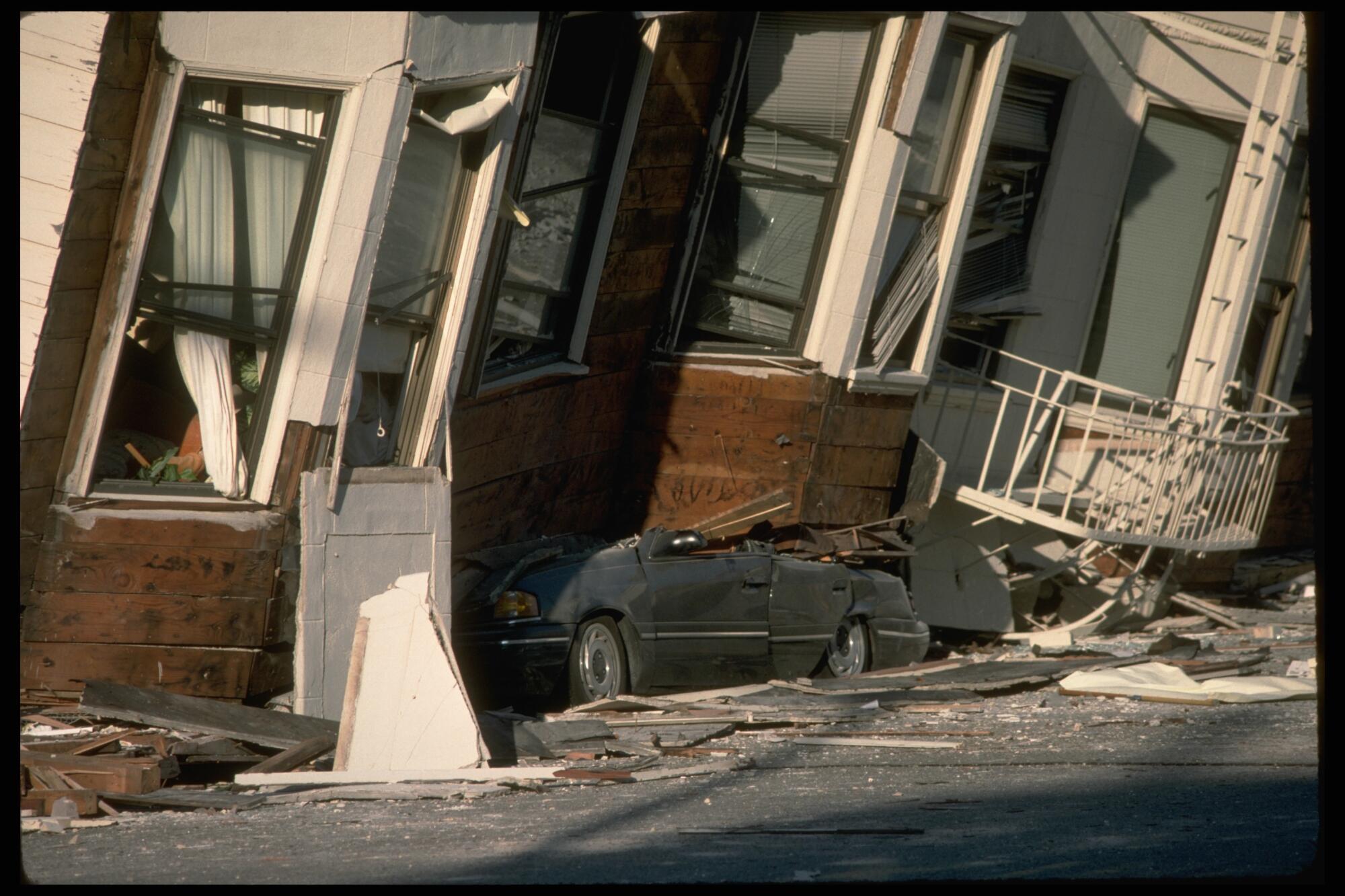
San José has an estimated 3,000 to 3,500 soft-story apartment buildings. The ordinance will take effect April 1, launching an 18-month screening phase where owners of suspected vulnerable buildings will be asked to fill out a form to help determine whether retrofits are needed. Owners will be given five to seven years to complete that work, with tighter deadlines set for larger and older apartment buildings.
The Burbank City Council in September voted unanimously to introduce a mandatory soft-story retrofit law. There are about 675 soft-story residential buildings with three or more units in the city of about 105,000. A second vote, expected on Dec. 10, is needed for the ordinance to be formally adopted.
“We’re trying to save lives,” said Mario Osuna, Burbank’s building official and assistant community development director.
One of the dangers may come as a surprise to homeowners, as even relatively newer homes may have this defect.
Burbank had a voluntary soft-story retrofit program that began in 1998, but progress has been limited, with only 35 retrofits completed since 2008, according to a recent staff report.
The Los Angeles County Board of Supervisors has ordered an inventory for soft-story apartment buildings owned or overseen by the county or its development authority, as well as in unincorporated areas, where more than 1 million people live. These are areas in the county not governed by a city council, such as East Los Angeles, Florence-Firestone, Hacienda Heights, South Whittier, Rowland Heights, Westmont, Altadena and Willowbrook. The inventory is expected to be complete in 2026, according to the county Department of Public Works.

If the county eventually does proceed with a mandatory soft-story apartment retrofit law for the unincorporated area, Alhambra building officials would review and consider whether to bring it to their city council to adopt, Ho said.
(Separately, county officials plan to consider a mandatory law to retrofit a different type of vulnerable structure — nonductile concrete buildings — for high-rise buildings in the unincorporated area, as well as those owned by the county. That is expected to be considered in early 2025.)
An earthquake safety revolution is sweeping L.A. apartments. But how far will it spread?
A 2015 law enacted in the city of Los Angeles requires retrofits of soft-story buildings that have two or more stories, a wood-frame construction and ground-floor parking or a similar open floor space on that first story. The law does not affect buildings with three or fewer residential units, as long as the building is only used for housing. The law requires that retrofits be done within seven years after an owner receives an order to comply. For some buildings, that means the deadline passed last year.
Long Beach has a preliminary inventory of soft-story apartment buildings and has launched outreach meetings to educate tenants and property owners on what could happen if nothing is done before the next big earthquake. The exact number is unclear, but there could be close to 3,000 soft-story apartment buildings in the city.
“We have also notified the property owners that we feel like their buildings are seismically prone and they may be considered soft story,” said David Khorram, Long Beach’s superintendent of building and safety.
The draft list was released to property owners in August, but not yet to the public, offering owners a chance to correct the city’s draft list, officials said. Pending approval by the city council, the list could be made public early next year. Officials said they hope the program will encourage owners to voluntarily strengthen their buildings.
There’s now an entire generation of Californians who have grown up without experiencing the damaging earthquakes we saw in the 1980s and 1990s.
Even smaller cities have passed mandatory retrofit ordinances. The city council of Albany, a community of 20,000 residents northwest of Berkeley, unanimously passed a retrofit law in 2023. The law is estimated to affect 150 apartment buildings, containing 800 units.
“At some point, we will have a major earthquake. It’s really a question of when,” said Michelle Plouse, a community development analyst for the city. “Earthquake risk is a really, really major concern for our city.”
The risk of soft-story apartment buildings is clear in Burlingame, where they line El Camino Real, the main road through the wealthy city just south of San Francisco International Airport. There are an estimated 140 soft-story apartment buildings there, said Rick Caro, chief building official for the city of 31,000 people.
A committee has been formed to figure out a way to “evaluate the costs and benefits of potential actions,” officials said.
Monday’s magnitude 4.4 earthquake — centered near Highland Park — came with an early warning from California’s quake alert system.
Other cities have been thwarted in their retrofitting efforts. Mountain View, one of the most populous cities in Silicon Valley, stopped work on an earthquake retrofit program in 2021 “due to lack of funding and staffing resources,” according to Lenka Wright, a spokesperson for the city.
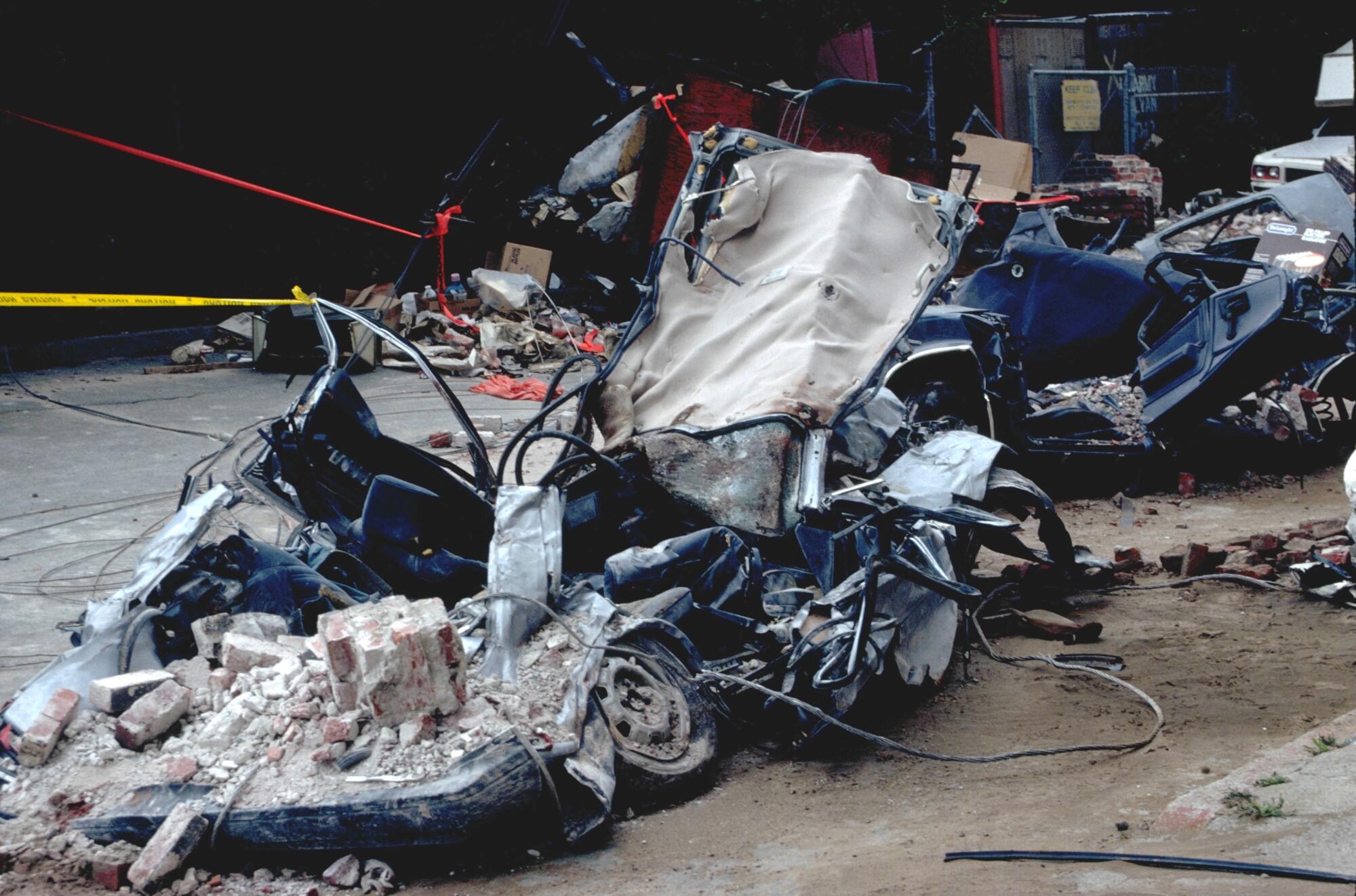
Palo Alto has been talking about soft-story apartments for years, and in 2016 identified 294 such buildings, said city spokesperson Meghan Horrigan-Taylor. The city council is expected to weigh in December whether to hire engineering consultants to update the city’s inventory and propose a combination of voluntary and mandatory measures “as appropriate based on structural need,” Horrigan-Taylor said. If the council green lights the proposal, staffers expect the update and recommendations will be completed in 15 months.
Times staff writer Rebecca Ellis contributed to this report.
More to Read
Sign up for Essential California
The most important California stories and recommendations in your inbox every morning.
You may occasionally receive promotional content from the Los Angeles Times.
